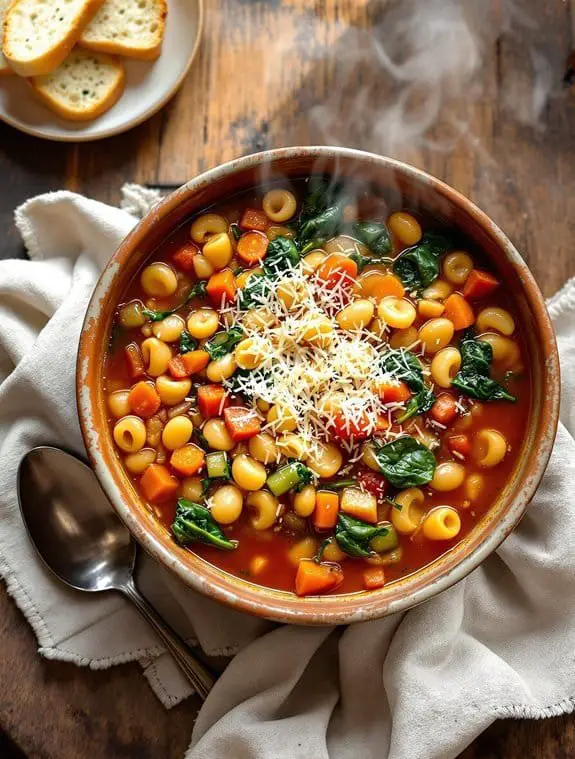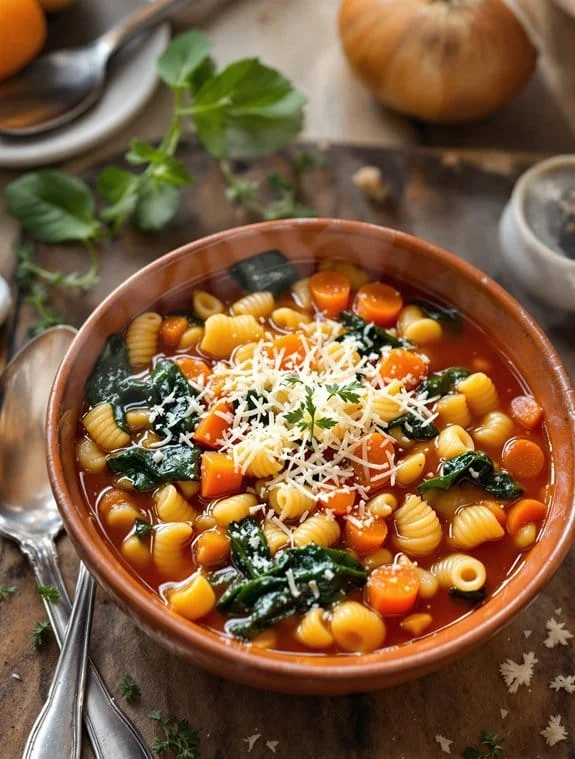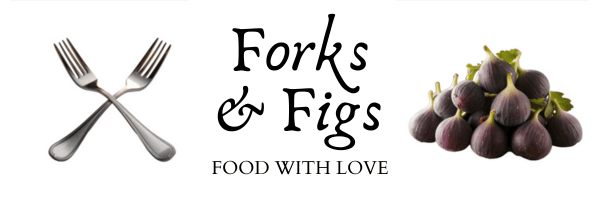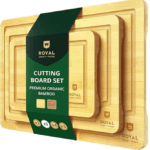Italian Minestrone Soup Recipe From Scratch

I’m about to share the minestrone recipe that’ll make you question why you ever bought the canned stuff. This isn’t just another vegetable soup—it’s a canvas where whatever’s lurking in your fridge gets transformed into something magical. The best part? You probably have most ingredients already, and I’ll show you exactly how to layer flavors so each spoonful tastes like you’ve been simmering it for hours.
Why You’ll Love this Italian Minestrone Soup
What’s not to love about a soup that’s basically a warm hug in a bowl?
This minestrone hits every comfort food note I crave. It’s packed with vegetables, beans, and pasta, so you’re getting a complete meal that’ll actually fill you up.
The best part? You probably have most ingredients already. No fancy shopping trips or weird substitutions required.
Plus, it’s incredibly forgiving – toss in whatever vegetables are hanging out in your fridge. I’m talking serious flexibility here.
And honestly, your kitchen will smell absolutely amazing while it simmers.
What Ingredients are in Italian Minestrone Soup?
This Italian minestrone is basically the “everything plus the kitchen sink” soup we all need in our lives, but somehow it works perfectly. The ingredient list might look long at first glance, but trust me when I say you probably already have half of these items lurking in your pantry right now.
The beauty of minestrone lies in its flexibility – it’s not precious about exact measurements or specific brands. Think of this ingredient list as your starting point, not your rigid rulebook. You can swap, substitute, and adjust based on what’s actually sitting in your fridge.
Essential Ingredients:
- 4 tablespoons extra-virgin olive oil (divided)
- 1 medium yellow onion, chopped
- 2 medium carrots, peeled and chopped
- 2 medium celery ribs, chopped
- 2–3 cloves garlic, minced
- 1 (28 oz) can diced tomatoes
- 5 cups vegetable broth
- 1 cup small pasta (ditalini, elbows)
- 1 (15 oz) can beans (cannellini, navy, or kidney)
- Greens (spinach, kale), chopped
- Salt, pepper, dried oregano, bay leaf
- Grated Parmesan for serving
Ingredient Flexibility and Substitutions
Let’s talk about where you can get creative with these ingredients. The vegetable base of onion, carrots, and celery is pretty sacred – it’s called a mirepoix and it’s the flavor foundation that makes everything else taste amazing.
But beyond that holy trinity, you’ve got wiggle room. For the beans, honestly any canned variety works wonderfully. Cannellini beans are traditional and creamy, navy beans are mild and comforting, while kidney beans bring a heartier texture. Just drain and rinse whatever you choose to get rid of that weird canned liquid.
The pasta situation is where things get fun. Ditalini are those cute little tubes that are perfect for soup, but elbow macaroni works just as well. Really, any small pasta shape will do – think shells, rotini, or even broken spaghetti if that’s what you’ve got. Just avoid anything too delicate that might turn to mush.
When it comes to greens, spinach wilts down quickly and adds a mild flavor, while kale brings more substance and a slightly bitter note that balances the sweetness of the tomatoes. Baby spinach is probably the easiest since it doesn’t need any chopping, but don’t stress if you only have the regular stuff.
How to Make this Italian Minestrone Soup

Making minestrone soup is one of those cooking experiences that feels like you’re conducting a delicious orchestra, where each ingredient joins the symphony at exactly the right moment. The whole process is surprisingly forgiving, which means even if you get distracted scrolling through your phone (we’ve all been there), you’ll probably still end up with something amazing.
Start with the Foundation
Heat 4 tablespoons of extra-virgin olive oil in a large pot over medium heat. You want that oil nice and warm, but not smoking like an angry dragon.
Add your 1 medium chopped yellow onion, 2 chopped carrots, and 2 chopped celery ribs all at once. This is where the magic begins – that beautiful sizzling sound means flavor is happening.
Let these vegetables sauté until they’re soft and the onion becomes translucent, which usually takes about 5 to 7 minutes. Don’t rush this step by cranking up the heat. You want them to soften gently, not brown aggressively. Think of it as a gentle warm-up before the main event.
Build the Flavor Base
Once your vegetables look tender and smell incredible, add 2 to 3 minced garlic cloves to the pot. Cook this mixture for just about a minute until you can smell that unmistakable garlic fragrance wafting up.
Garlic burns faster than you think, so don’t wander off during this part.
Now comes the satisfying moment where you dump in your 28-ounce can of diced tomatoes, 5 cups of vegetable broth, and your 15-ounce can of drained and rinsed beans.
Add your dried oregano, bay leaf, and a generous pinch of salt and pepper. Watch everything come together into this beautiful, chunky mixture that already looks like soup.
Let It All Simmer
Bring this gorgeous concoction to a gentle boil, then reduce the heat to let it simmer peacefully for 10 to 15 minutes.
This is when all those flavors start mingling and getting to know each other. The tomatoes break down slightly, the vegetables get even more tender, and everything starts tasting like it belongs together.
During this time, you can taste and adjust the seasoning. Maybe it needs more salt, or perhaps another pinch of oregano. Trust your taste buds – they know what they’re doing.
Finish Strong
Add your 1 cup of small pasta and chopped greens to the pot. The pasta will cook directly in the soup, absorbing all those beautiful flavors while it softens.
This usually takes about 8 to 10 minutes, depending on what type of pasta you’re using. Check the package directions, but also taste-test a piece to make sure it’s not still crunchy.
The greens will wilt down dramatically – especially spinach, which basically disappears into the soup like a magic trick. Kale takes a bit longer to soften, so if you’re using that, you might want to add it a minute or two before the pasta.
The Final Touch
Once your pasta is perfectly tender and your greens are wilted, remove that bay leaf (nobody wants to bite into that surprise), and give everything one final taste.
Adjust the salt and pepper as needed, then ladle this masterpiece into bowls and top with grated Parmesan cheese.
The beauty of this whole process is that it’s almost impossible to mess up. Soup is forgiving like that – it wants to be delicious, and it’ll work with you even if your timing isn’t perfect.
Italian Minestrone Soup Substitutions and Variations
Because minestrone is basically the rebel of the soup world, you can swap out almost any ingredient and it’ll still taste incredible.
Don’t have ditalini pasta? Throw in whatever small pasta you’ve got lurking in your pantry.
No cannellini beans? Kidney beans work perfectly fine. I’m a firm believer that minestrone doesn’t judge your ingredient choices.
Want to make it heartier? Add some Italian sausage or ground beef.
Craving more vegetables? Toss in zucchini, bell peppers, or green beans.
The beauty is in its flexibility, making it perfect for cleaning out your fridge.
What to Serve with Italian Minestrone Soup
What goes perfectly with a steaming bowl of minestrone? I’d say crusty Italian bread, hands down. You know, the kind that makes that satisfying crunch when you tear it apart.
A simple green salad works wonders too. Nothing fancy—just mixed greens with olive oil and balsamic vinegar. The crisp freshness cuts through the soup’s heartiness beautifully.
Want something more substantial? Grilled cheese sandwiches are my guilty pleasure pairing. Sure, it’s not traditionally Italian, but who’s judging? The melty cheese and buttery bread make every spoonful even more comforting.
Final Thoughts
After all my rambling about beans and pasta shapes, here’s what really matters: minestrone isn’t just a recipe, it’s permission to clean out your fridge guilt-free.
Got wilted vegetables? Perfect. Random pasta lurking in your pantry? Even better. Half a can of beans you forgot about? Chef’s kiss.
This soup doesn’t judge. It embraces chaos in the most delicious way possible. Each spoonful becomes a little adventure—what vegetable will you discover next? Will you find that elusive piece of pasta you’ve been chasing with your spoon?
That’s the magic of homemade minestrone.

Minestrone Soup From Scratch
Ingredients
- 4 tablespoons extra-virgin olive oil divided
- 1 medium yellow onion chopped
- 2 medium carrots peeled and chopped
- 2 medium celery ribs chopped
- 2-3 cloves garlic minced
- 1 28 oz can diced tomatoes
- 5 cups vegetable broth
- 1 cup small pasta ditalini or elbows
- 1 15 oz can beans (cannellini, navy, or kidney), drained and rinsed
- 2 cups fresh greens spinach or kale, chopped
- 1 teaspoon dried oregano
- 1 bay leaf
- Salt and black pepper to taste
- Grated Parmesan cheese for serving
Instructions
- Heat 3 tablespoons of olive oil in a large pot over medium heat.
- Add chopped onion, carrots, and celery. Sauté for 5-7 minutes until vegetables are softened.
- Add minced garlic and cook for 1 minute until fragrant.
- Stir in diced tomatoes, vegetable broth, oregano, bay leaf, and beans.
- Bring mixture to a boil, then reduce heat and simmer for 10-15 minutes.
- Add pasta and cook according to package directions until al dente.
- Stir in chopped greens and cook for 2-3 minutes until wilted.
- Remove bay leaf and season with salt and pepper to taste.
- Drizzle with remaining olive oil and serve with grated Parmesan cheese.
Notes
Nutrition
Frequently Asked Questions
Can I Freeze Leftover Minestrone Soup for Later?
I’d recommend freezing your leftover minestrone without the pasta since it gets mushy when reheated. Freeze the soup base for up to three months, then add fresh pasta when you’re ready to serve it again.
How Long Does Homemade Minestrone Soup Last in the Refrigerator?
I’d store your homemade minestrone soup in the refrigerator for up to four days. I’ll keep it in airtight containers and reheat thoroughly before serving. Don’t let it sit longer than that.
What’s the Difference Between Minestrone and Other Italian Vegetable Soups?
I’ll explain what sets minestrone apart from other Italian vegetable soups. Minestrone’s defining feature is its hearty combination of pasta, beans, and mixed vegetables, while other soups typically focus on fewer key ingredients.
Can I Make Minestrone Soup in a Slow Cooker or Instant Pot?
I’ll adapt this minestrone recipe for both appliances. For slow cooker, combine everything except pasta and greens, cook on low 6-8 hours, then add pasta and greens last 30 minutes.
Why Does My Minestrone Soup Taste Bland and How Can I Fix It?
I’ll fix your bland minestrone by adding more salt, acid from lemon juice or vinegar, fresh herbs, garlic, and quality Parmesan. Taste frequently while cooking and adjust seasonings generously.



